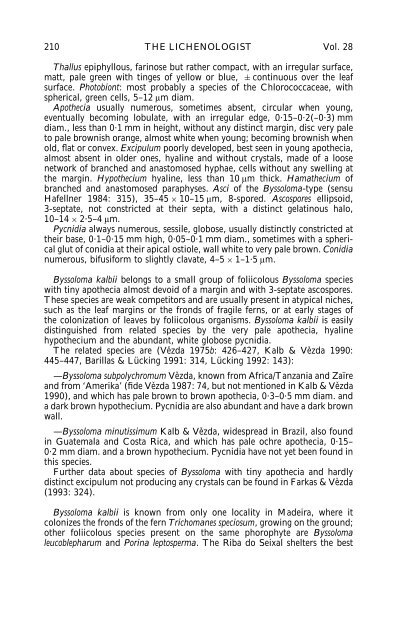Foliicolous lichens from Madeira, with the description of a new ...
Foliicolous lichens from Madeira, with the description of a new ...
Foliicolous lichens from Madeira, with the description of a new ...
You also want an ePaper? Increase the reach of your titles
YUMPU automatically turns print PDFs into web optimized ePapers that Google loves.
210 THE LICHENOLOGIST Vol. 28<br />
Thallus epiphyllous, farinose but ra<strong>the</strong>r compact, <strong>with</strong> an irregular surface,<br />
matt, pale green <strong>with</strong> tinges <strong>of</strong> yellow or blue, continuous over <strong>the</strong> leaf<br />
surface. Photobiont: most probably a species <strong>of</strong> <strong>the</strong> Chlorococcaceae, <strong>with</strong><br />
spherical, green cells, 5–12 μm diam.<br />
Apo<strong>the</strong>cia usually numerous, sometimes absent, circular when young,<br />
eventually becoming lobulate, <strong>with</strong> an irregular edge, 0·15–0·2(–0·3) mm<br />
diam., less than 0·1 mm in height, <strong>with</strong>out any distinct margin, disc very pale<br />
to pale brownish orange, almost white when young; becoming brownish when<br />
old, flat or convex. Excipulum poorly developed, best seen in young apo<strong>the</strong>cia,<br />
almost absent in older ones, hyaline and <strong>with</strong>out crystals, made <strong>of</strong> a loose<br />
network <strong>of</strong> branched and anastomosed hyphae, cells <strong>with</strong>out any swelling at<br />
<strong>the</strong> margin. Hypo<strong>the</strong>cium hyaline, less than 10 μm thick. Hama<strong>the</strong>cium <strong>of</strong><br />
branched and anastomosed paraphyses. Asci <strong>of</strong> <strong>the</strong> Byssoloma-type (sensu<br />
Hafellner 1984: 315), 35–4510–15 μm, 8-spored. Ascospores ellipsoid,<br />
3-septate, not constricted at <strong>the</strong>ir septa, <strong>with</strong> a distinct gelatinous halo,<br />
10–142·5–4 μm.<br />
Pycnidia always numerous, sessile, globose, usually distinctly constricted at<br />
<strong>the</strong>ir base, 0·1–0·15 mm high, 0·05–0·1 mm diam., sometimes <strong>with</strong> a spherical<br />
glut <strong>of</strong> conidia at <strong>the</strong>ir apical ostiole, wall white to very pale brown. Conidia<br />
numerous, bifusiform to slightly clavate, 4–51–1·5 μm.<br />
Byssoloma kalbii belongs to a small group <strong>of</strong> foliicolous Byssoloma species<br />
<strong>with</strong> tiny apo<strong>the</strong>cia almost devoid <strong>of</strong> a margin and <strong>with</strong> 3-septate ascospores.<br />
These species are weak competitors and are usually present in atypical niches,<br />
such as <strong>the</strong> leaf margins or <strong>the</strong> fronds <strong>of</strong> fragile ferns, or at early stages <strong>of</strong><br />
<strong>the</strong> colonization <strong>of</strong> leaves by foliicolous organisms. Byssoloma kalbii is easily<br />
distinguished <strong>from</strong> related species by <strong>the</strong> very pale apo<strong>the</strong>cia, hyaline<br />
hypo<strong>the</strong>cium and <strong>the</strong> abundant, white globose pycnidia.<br />
The related species are (Vězda 1975b: 426–427, Kalb & Vězda 1990:<br />
445–447, Barillas & Lücking 1991: 314, Lücking 1992: 143):<br />
—Byssoloma subpolychromum Vězda, known <strong>from</strong> Africa/Tanzania and Zaïre<br />
and <strong>from</strong> ‘Amerika’ (fide Vězda 1987: 74, but not mentioned in Kalb & Vězda<br />
1990), and which has pale brown to brown apo<strong>the</strong>cia, 0·3–0·5 mm diam. and<br />
a dark brown hypo<strong>the</strong>cium. Pycnidia are also abundant and have a dark brown<br />
wall.<br />
—Byssoloma minutissimum Kalb & Vězda, widespread in Brazil, also found<br />
in Guatemala and Costa Rica, and which has pale ochre apo<strong>the</strong>cia, 0·15–<br />
0·2 mm diam. and a brown hypo<strong>the</strong>cium. Pycnidia have not yet been found in<br />
this species.<br />
Fur<strong>the</strong>r data about species <strong>of</strong> Byssoloma <strong>with</strong> tiny apo<strong>the</strong>cia and hardly<br />
distinct excipulum not producing any crystals can be found in Farkas & Vězda<br />
(1993: 324).<br />
Byssoloma kalbii is known <strong>from</strong> only one locality in <strong>Madeira</strong>, where it<br />
colonizes <strong>the</strong> fronds <strong>of</strong> <strong>the</strong> fern Trichomanes speciosum, growing on <strong>the</strong> ground;<br />
o<strong>the</strong>r foliicolous species present on <strong>the</strong> same phorophyte are Byssoloma<br />
leucoblepharum and Porina leptosperma. The Riba do Seixal shelters <strong>the</strong> best
















